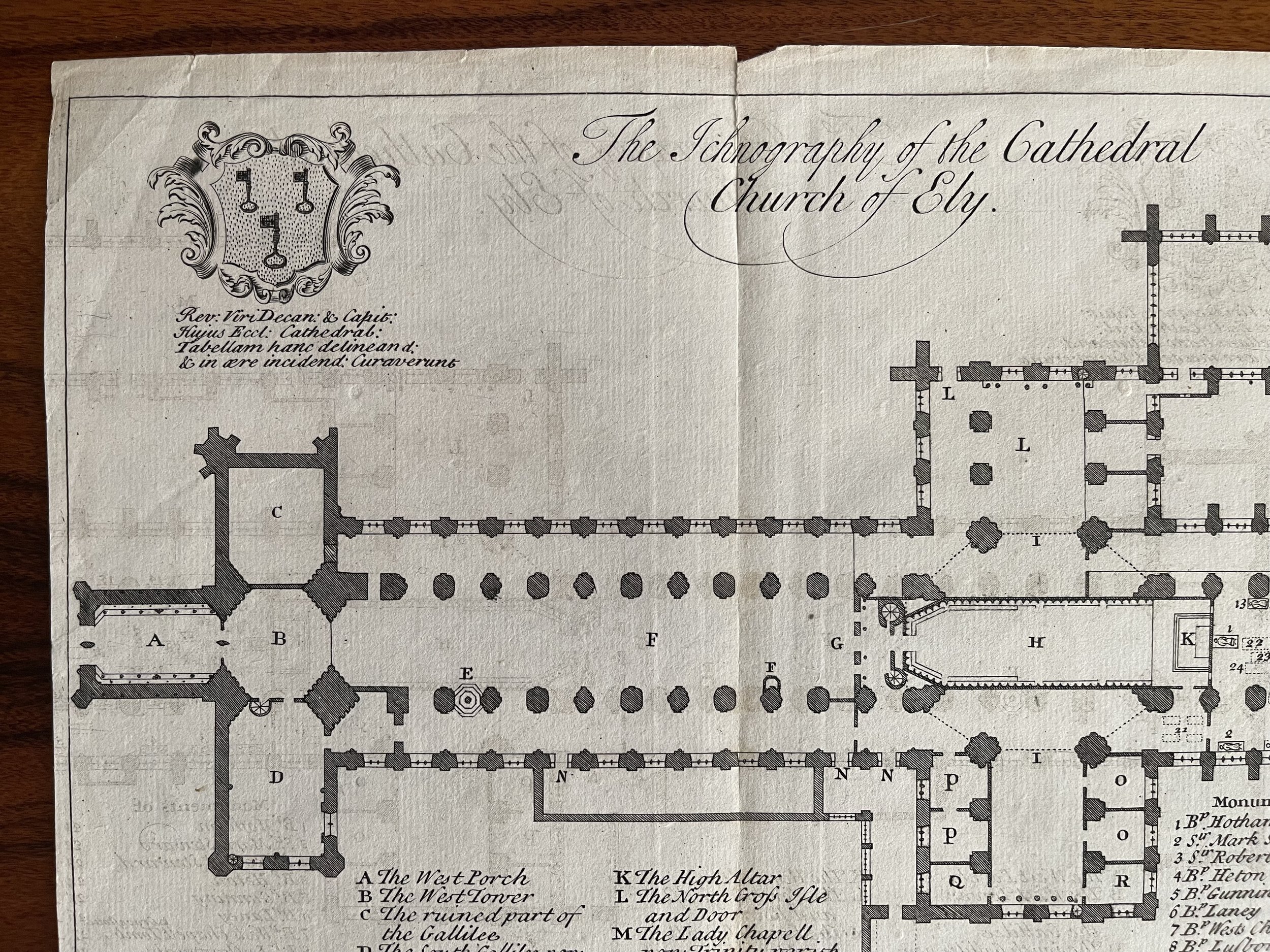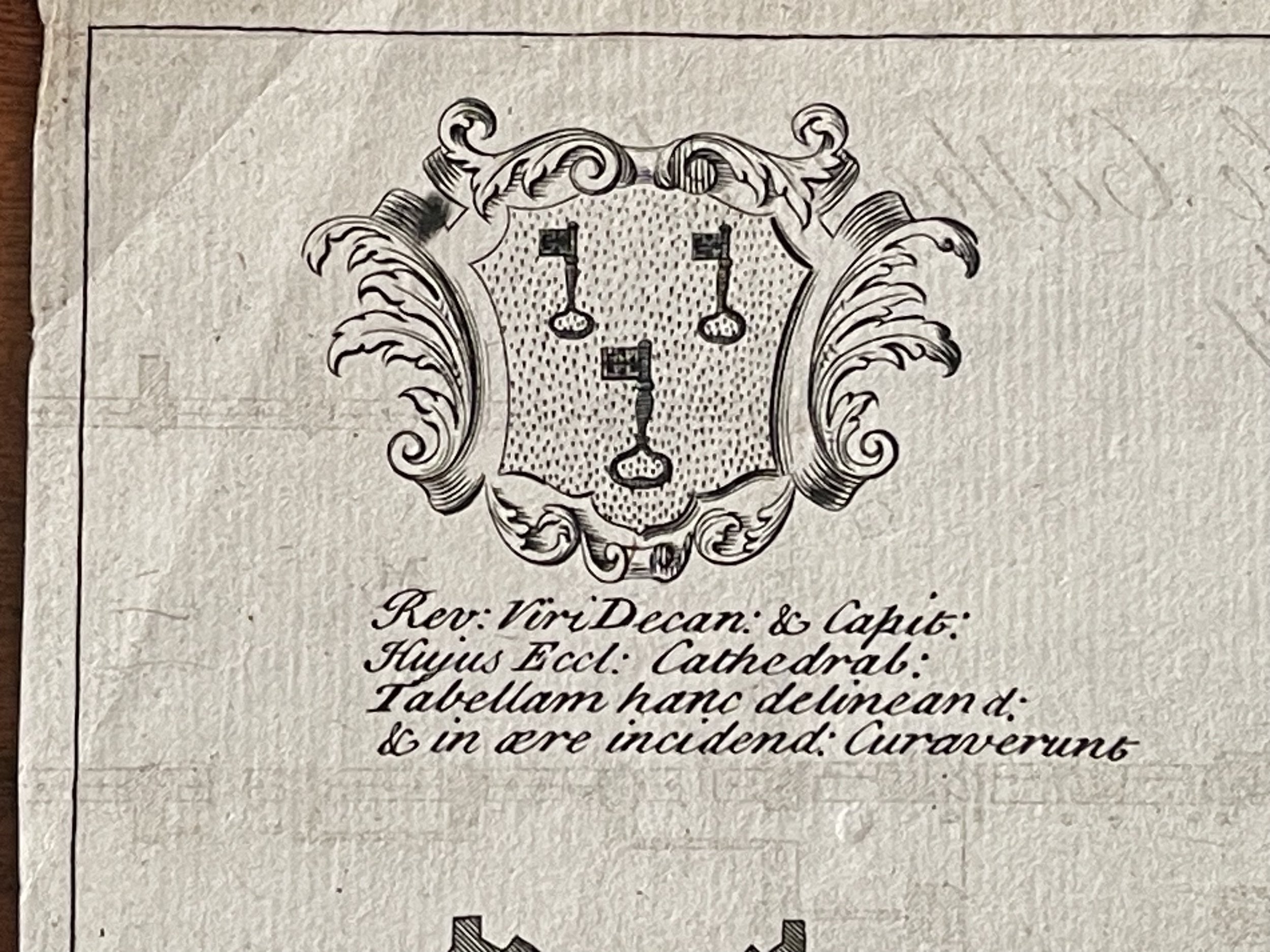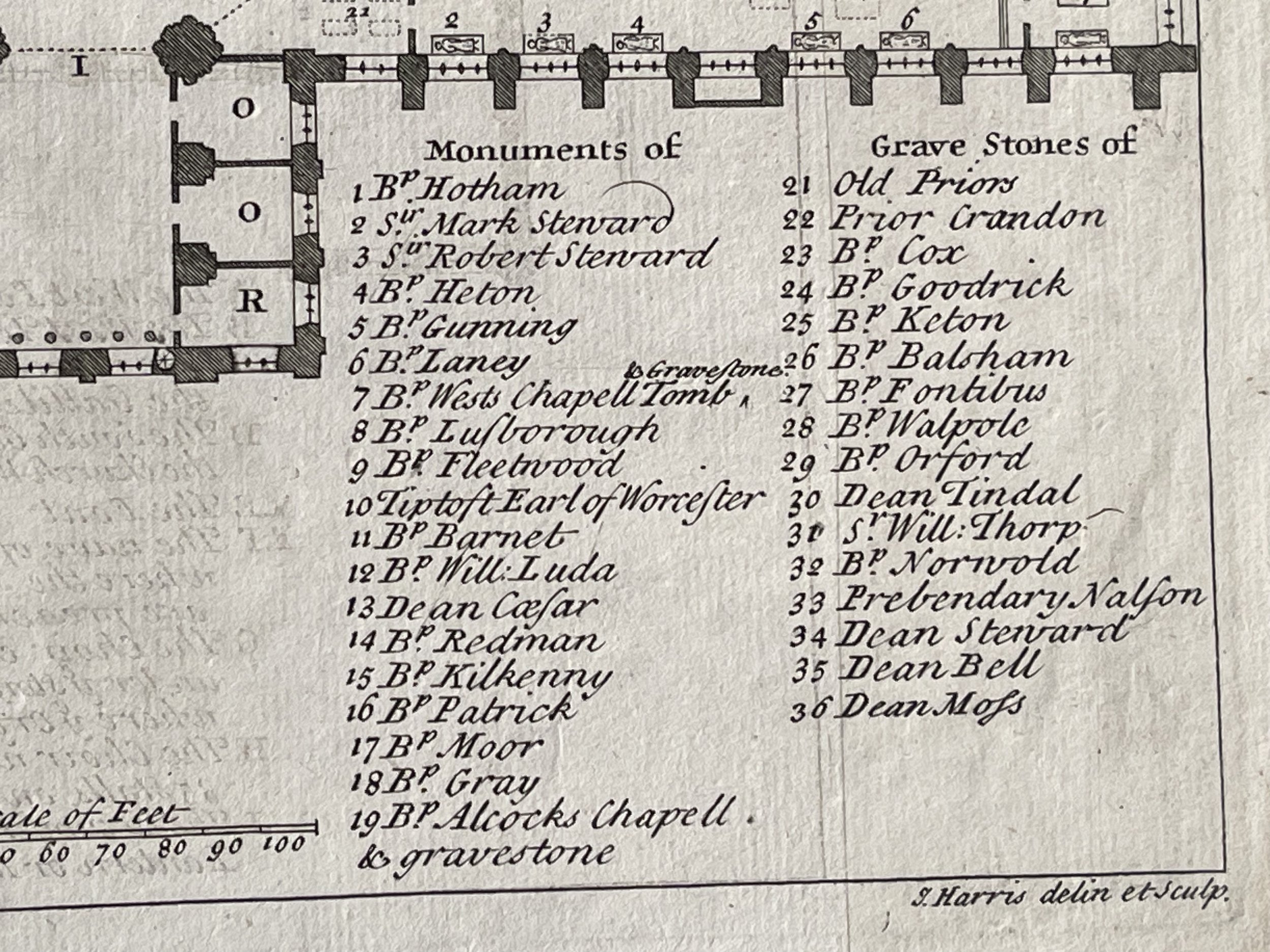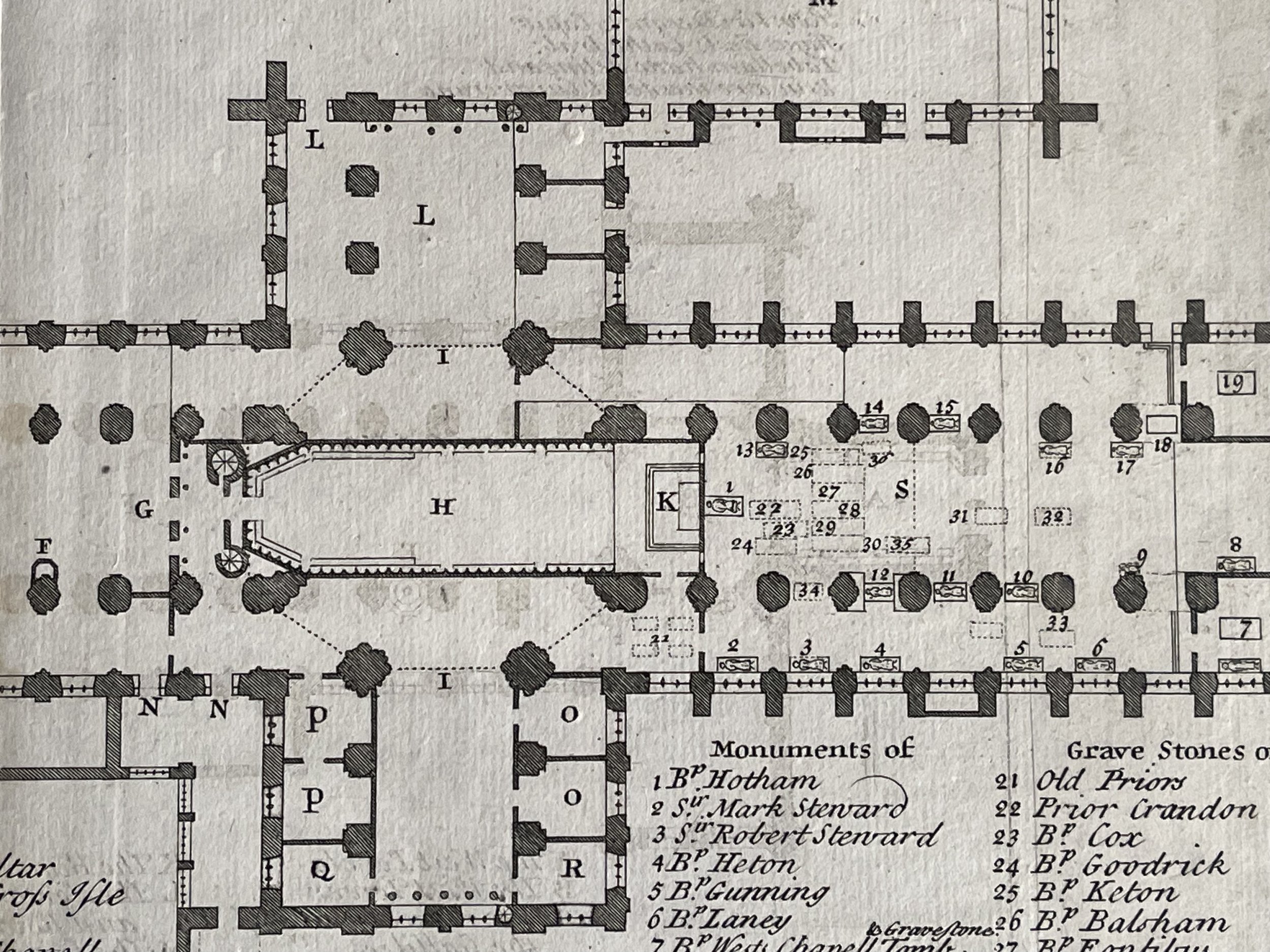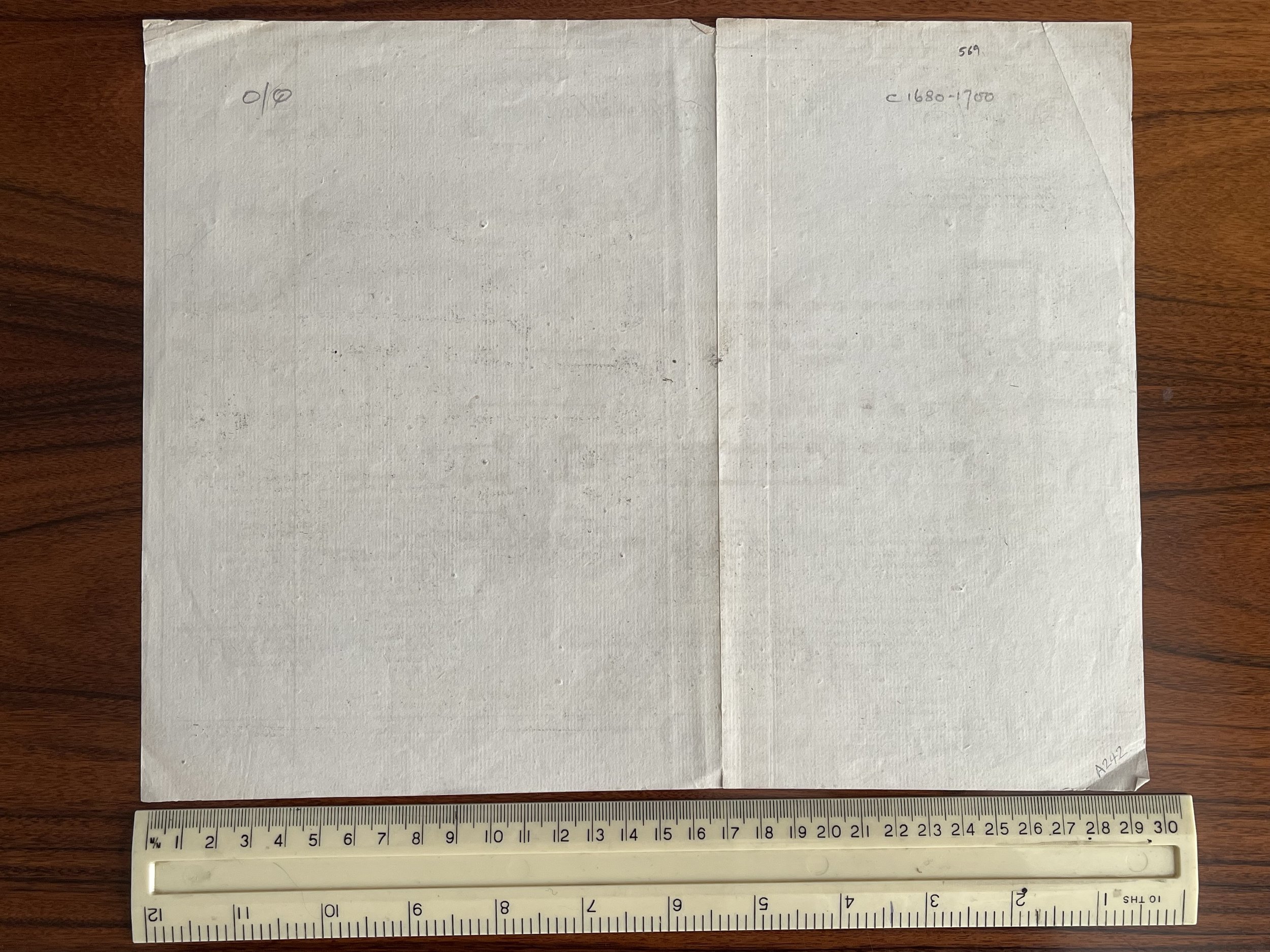The Ichnography / Plan of the Cathedral Church of Ely, Cambridgeshire - John Harris - 1730
The Ichnography of the Cathedral Church of Ely. Author Harris, John 8.69.d. Place of publication: [London] Publisher: [R. Gosling] Date of publication: [1730.] Item type: copperplate engraving Dimensions: 20.1 x 28.7 cm George III, King of Great Britain, 1738-1820 also possessed this engraving in his collection.
History of Ely Cathedral
A religious house was founded on the present site by Etheldreda, a daughter of Anna King of East Anglia, in 673. The monastery was laid waste by the Danes in 870, refounded by Ethelwold, Bishop of Winchester, as a Benedictine abbey in 970 and dedicated to St. Peter and the Blessed Virgin by Dunstan in 974. The building of the present church and monastic buildings was begun under Simeon the first Norman abbot. Bishop Northwold rededicated the church on the completion of a new presbytery about 1250 in honour of the Virgin, St. Peter, and St. Etheldreda. At the time of the Dissolution the dedication was St. Peter and St. Etheldreda when it was changed to the Holy and Undivided Trinity. An indenture between Henry VIII and the bishop has 'the convent of St. Audre's in Ely'. The House was surrendered to the king on 18 November 1539. The New Foundation consisted of a dean, 8 prebendaries, 8 minor canons, deacon and sub-deacon, 24 scholars, 2 schoolmasters, an organist, and various singing men and boys; the prior Robert Wells or Steward became dean; the Almonry School was refounded as the 'Kings School' and still continues. This establishment continued, with the break from 1649 to 1661, with little change until the 19th century. By the Cathedrals Act (1840) the number of canonries was reduced to 6, and in the last few years has been reduced to 4. One canonry is annexed to the Ely Professorship of Divinity in the University of Cambridge, and one of the lapsed canonries was annexed to the Regius Professorship of Hebrew. There are now 24 honorary canons.
The name was in use at Ely at least as early as 1340-2 and probably very much earlier; it occurs at Durham in 1186 which was about the time that the Ely porch was first planned.
The Ichnography of the Cathedral Church of Ely. Author Harris, John 8.69.d. Place of publication: [London] Publisher: [R. Gosling] Date of publication: [1730.] Item type: copperplate engraving Dimensions: 20.1 x 28.7 cm George III, King of Great Britain, 1738-1820 also possessed this engraving in his collection.
History of Ely Cathedral
A religious house was founded on the present site by Etheldreda, a daughter of Anna King of East Anglia, in 673. The monastery was laid waste by the Danes in 870, refounded by Ethelwold, Bishop of Winchester, as a Benedictine abbey in 970 and dedicated to St. Peter and the Blessed Virgin by Dunstan in 974. The building of the present church and monastic buildings was begun under Simeon the first Norman abbot. Bishop Northwold rededicated the church on the completion of a new presbytery about 1250 in honour of the Virgin, St. Peter, and St. Etheldreda. At the time of the Dissolution the dedication was St. Peter and St. Etheldreda when it was changed to the Holy and Undivided Trinity. An indenture between Henry VIII and the bishop has 'the convent of St. Audre's in Ely'. The House was surrendered to the king on 18 November 1539. The New Foundation consisted of a dean, 8 prebendaries, 8 minor canons, deacon and sub-deacon, 24 scholars, 2 schoolmasters, an organist, and various singing men and boys; the prior Robert Wells or Steward became dean; the Almonry School was refounded as the 'Kings School' and still continues. This establishment continued, with the break from 1649 to 1661, with little change until the 19th century. By the Cathedrals Act (1840) the number of canonries was reduced to 6, and in the last few years has been reduced to 4. One canonry is annexed to the Ely Professorship of Divinity in the University of Cambridge, and one of the lapsed canonries was annexed to the Regius Professorship of Hebrew. There are now 24 honorary canons.
The name was in use at Ely at least as early as 1340-2 and probably very much earlier; it occurs at Durham in 1186 which was about the time that the Ely porch was first planned.
The Ichnography of the Cathedral Church of Ely. Author Harris, John 8.69.d. Place of publication: [London] Publisher: [R. Gosling] Date of publication: [1730.] Item type: copperplate engraving Dimensions: 20.1 x 28.7 cm George III, King of Great Britain, 1738-1820 also possessed this engraving in his collection.
History of Ely Cathedral
A religious house was founded on the present site by Etheldreda, a daughter of Anna King of East Anglia, in 673. The monastery was laid waste by the Danes in 870, refounded by Ethelwold, Bishop of Winchester, as a Benedictine abbey in 970 and dedicated to St. Peter and the Blessed Virgin by Dunstan in 974. The building of the present church and monastic buildings was begun under Simeon the first Norman abbot. Bishop Northwold rededicated the church on the completion of a new presbytery about 1250 in honour of the Virgin, St. Peter, and St. Etheldreda. At the time of the Dissolution the dedication was St. Peter and St. Etheldreda when it was changed to the Holy and Undivided Trinity. An indenture between Henry VIII and the bishop has 'the convent of St. Audre's in Ely'. The House was surrendered to the king on 18 November 1539. The New Foundation consisted of a dean, 8 prebendaries, 8 minor canons, deacon and sub-deacon, 24 scholars, 2 schoolmasters, an organist, and various singing men and boys; the prior Robert Wells or Steward became dean; the Almonry School was refounded as the 'Kings School' and still continues. This establishment continued, with the break from 1649 to 1661, with little change until the 19th century. By the Cathedrals Act (1840) the number of canonries was reduced to 6, and in the last few years has been reduced to 4. One canonry is annexed to the Ely Professorship of Divinity in the University of Cambridge, and one of the lapsed canonries was annexed to the Regius Professorship of Hebrew. There are now 24 honorary canons.
The name was in use at Ely at least as early as 1340-2 and probably very much earlier; it occurs at Durham in 1186 which was about the time that the Ely porch was first planned.
Code : A242
Cartographer : Cartographer / Engraver / Publisher: John Harris
Date : Publication Place / Date - London 1730
Size : Sheet size: Image Size: 23.5 x 30cm
Availability : Available
Type - Genuine Antique
Grading - A
Tracked postage, in casement. Please contact me for postal quotation outside of the UK.

